Supply Chain API and Its Role in Boosting Digital Transformation
Updated 06 Jul 2023
18 Min
1228 Views
Logistics companies participating in the supply chain (SC) need it to be resilient and flexible. This is reasonable: with such qualities, the businesses may operate in various conditions and optimize their activities in different areas of the chain of supplies. The Application Programming Interface (API) implemented into the supply chain management software can connect the logistics systems and boost company performance.
This article depicts the meaning of API supply chain software needs, their profitability for the logistics domain enterprises, integration peculiarities for SC business owners, and many more exciting details. Check our materials to dive deeper into API implementation!
What is Hidden Behind the API Abbreviation?
Supply chain functioning includes a lot of different flows connected to the goods movement from manufacturing to coming to the end customer. Of course, such a complex process should be managed appropriately, but it’s difficult as there are many platforms related to various SC activities.
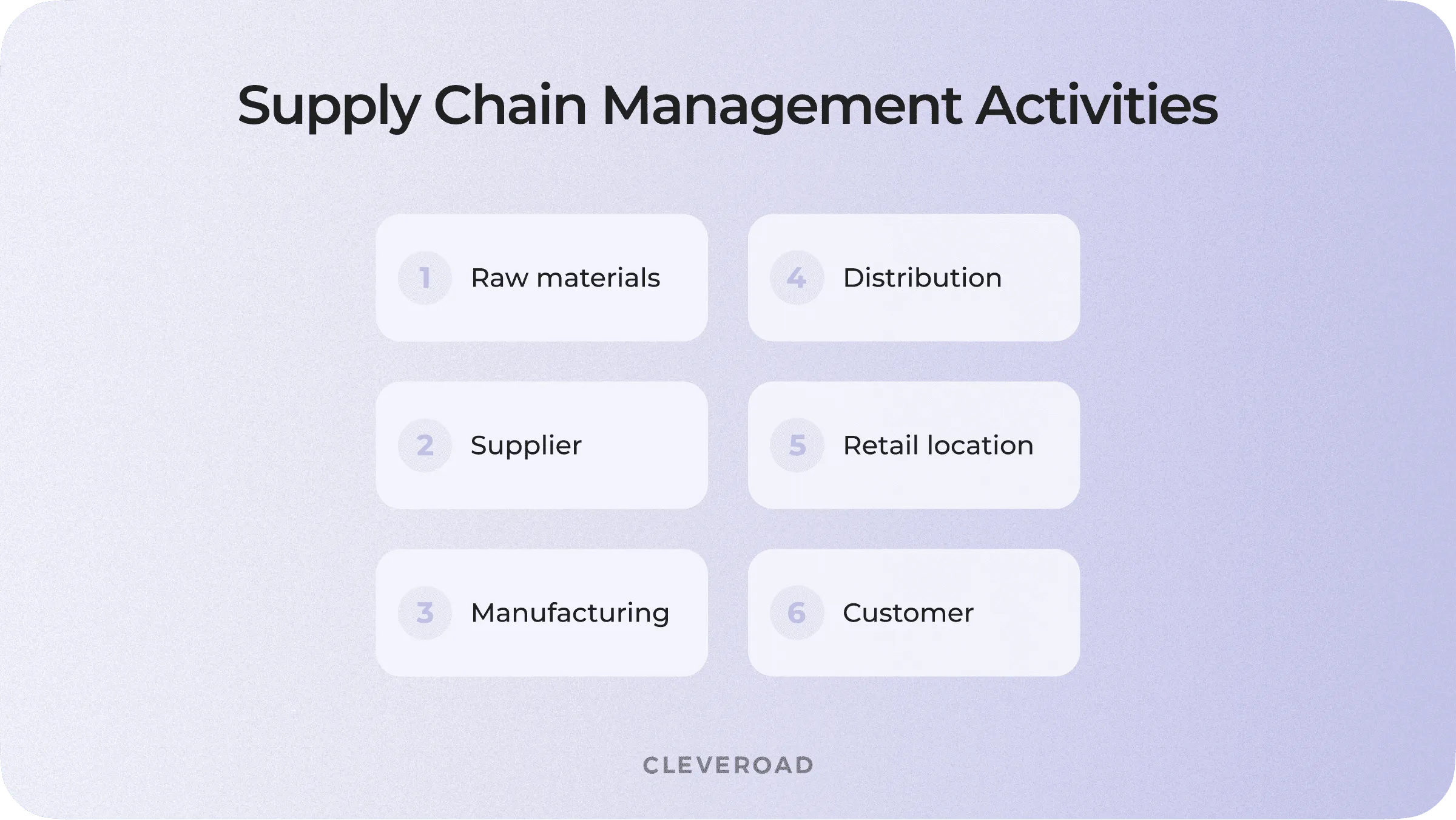
The variety of activities for the supply chain management
API in supply chain is capable of assisting users in dealing with the SCs more straightforwardly and monitoring the consequences of each activity. So, let’s research the essence of such proper instruments and find out how they can optimize the supply chain processes.
The Application Programming Interfaces (APIs) are code parts simplifying access to the collected data and functionality of the SC management solutions. They achieve such results by serving as digital mediators between software and data environments and even as interpreters of the supply chain data.
Before searching for an appropriate API for your logistics business software, learn what is an API by checking our article!
The meaning of supply chain API in logistics cannot be underestimated, and that’s why. Typically, entrepreneurs dealing with supply chain areas and activities have to handle various questions like which carrier to hire, how to act if the chosen airline company rejects the application for a freight shipment, or in what way to get information from different SC sections and how to estimate it, boosting the business income.
In this case, APIs work as an umbrella for different logistics systems, allowing the companies to connect their platforms to their carriers/suppliers' ones or other information sources and adding business logic to them. Such a thing saves time for business owners by offering centralized monitoring of various data (e.g., the fleet status, weather conditions, carriers’ location, etc.) necessary to complete an order from one source.
Additionally, APIs provide automatic billing between shippers, carriers, and 3PL partners, which helps minimize mistakes and guarantee prompt payments. Last but not least, APIs can enable carriers and shippers (3PLs) to exchange Proof of Delivery (POD) documentation, which has substantial benefits for effective supply chain integration.
Thinking of API integration in SC?
Apply to our experts, and obtain tech advice as to supply chain API integration for your project!
However, our discussion would be incomplete if we only analyzed API as the newest technology and didn’t mention EDI. Let’s find out more about these notions.
Electronic Data Interchange (EDI) means a digital exchange of documents between business partners. Due to it, many companies have increased the effectiveness of their business communication due to paperless docs. Consequently, the business operations of such companies have been improved, too, as well as their inventory management.
According to various statistical sources, more than 50% of SC executives choose APIs as a better alternative for their businesses than EDI. Nevertheless, we suppose that Electronic Data Interchange should by no means be considered “a loser.” You just need to look at API and EDI to decide what to use.
Below we make a small comparison to help you choose.
Typical use cases. EDI converts packaged data in batches from system to system. In turn, APIs enable connections to cloud apps that support APIs and allow a single request for information to be processed in real-time.
Standards of usage. EDI standards are established for each sector and location (with alternatives). However, there are no well-known, recognized standards for supply chain API.
Onboarding straightforwardness. New partners can be onboarded to EDI fast and efficiently, particularly those already linked to the provider's network. To build APIs, a data layer must first be created.
Data amount to work with. EDI can handle large data streams, whereas API is not designed to handle large amounts of information.
Pricing. While API is often priced per document, EDI is typically charged per kilo-character (KC).
Furthermore, there are some more differences you should pay attention to. They are mentioned in the table below.
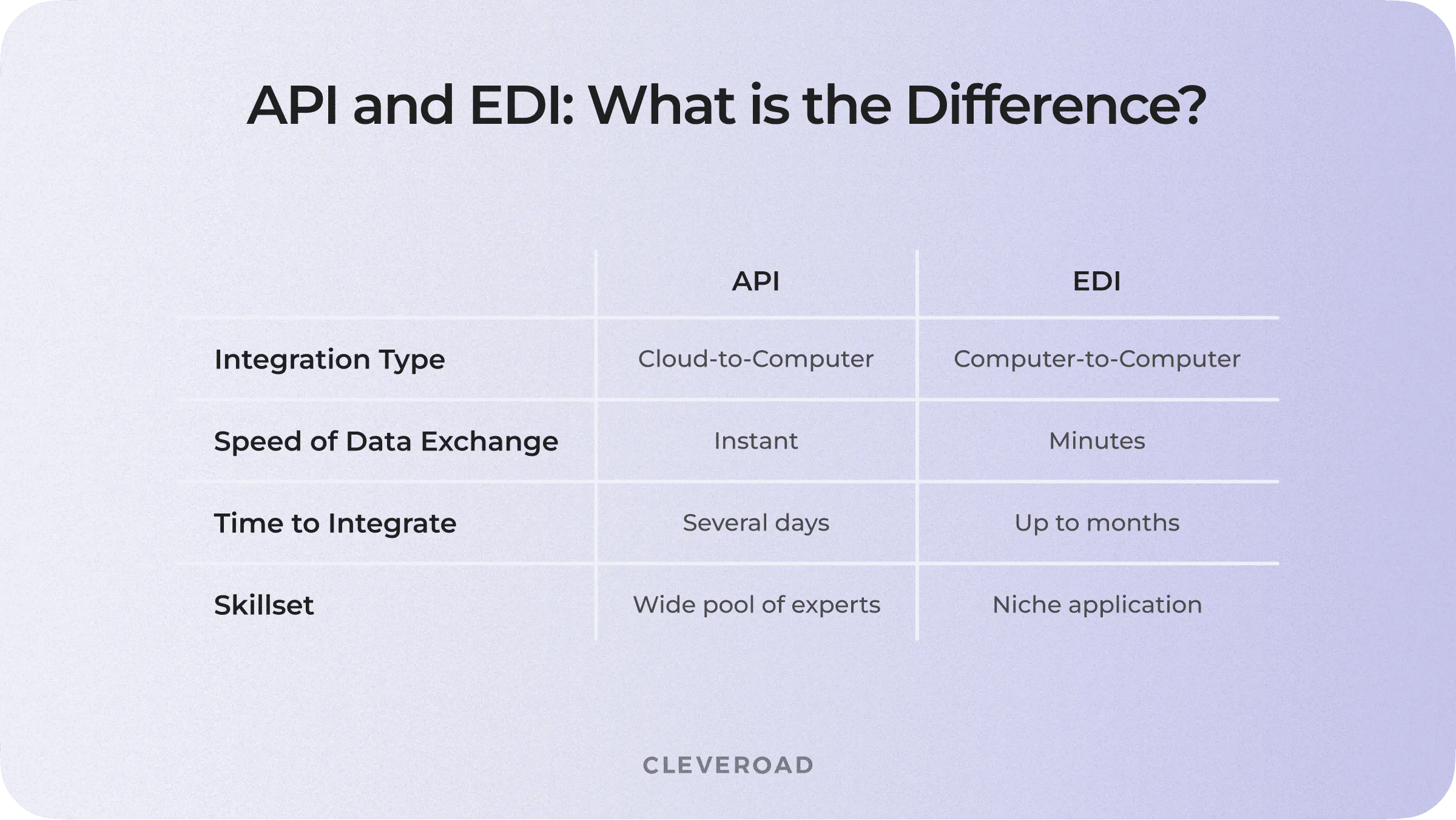
API vs. EDI: the comparison
It becomes evident that API and EDI have their own advantages and disadvantages. Nevertheless, EDI is alive and not outdated, but it has a bunch of hidden pitfalls you need to know about. It is hard and expensive to implement and maintain and too rigid to be adapted for the quick and dynamic workflows of today. So, supply chain API is the future of the logistics business domain.
The Value APIs Create in the Supply Chain and Logistics Processes
API in supply chain is the digital connector of one logistics system with the others critical to business success. The reason is it enables faster innovation and helps developers create customized business solutions to meet customer needs. As a result, companies can develop better products and bring them to market faster, staying ahead of the competition.
Let's learn more about the other essential benefits the API supply chain management software can get.
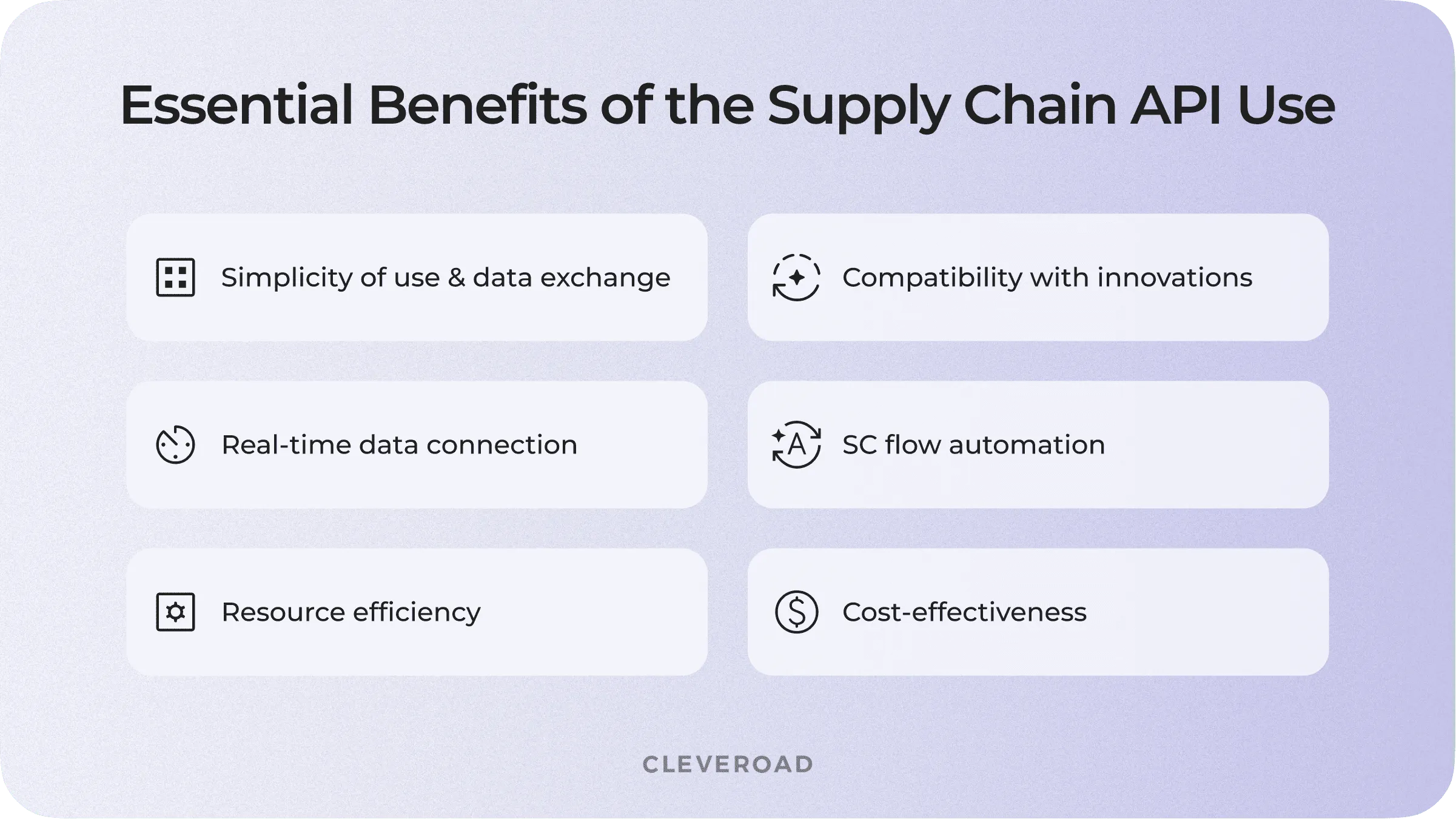
Typical advantages of the SC API use
Cost-efficiency
The API-supported networks may provide you with better shipping prices. This circumstance will allow your clients to make more flexible decisions to be fitted to their particular budget and business demands.
Resource efficiency during SC operations
Supply chain managers can distribute critical resources more efficiently since API-driven transactions require less inventory. Moreover, due to the excellent connectivity of one system to another, the company personnel may connect networks to share data about how the order is completed and how efficiently the resources are allocated and used.
Usage simplicity and speed of the data exchange
Using various CRM, ERP, or WMS systems, companies highly require these platforms' integration with the data from the chain of supplies. API can enable this integration, removing mediator file transfer servers and related processes to facilitate data sharing.
With the help of APIs, clients can get minute-by-minute updates on the progress of their shipments and even have the freedom to modify the shipment details following their schedule changes.
Data connection in a real-time mode
Integration of supply chain API provides connectivity and instant access to every system needed for a busy fulfillment center to deliver orders to customers. That's why data can be immediately gathered and shared across the parties. For instance, real-time shipment status can be communicated using APIs.
Automation of the supply chain processes
Some activities in the chain of supplies (e.g., sending requests to a carrier platform) can be sent automatically. It will economize the time of the company specialists. Furthermore, due to the tasks automatization, businesses can accomplish the following:
- Cut down on human error
- Streamline manual processes
- Boost supply chain transparency
Compatibility with technologies of the future
The corporate world's adoption of modern technologies (e.g., 5G, IoT, blockchain, machine learning, or AI) makes them more crucial for drawing out the insights from the data you need to enhance business outcomes. APIs are easily adaptable for such a technology use.
Enjoy API benefits for your SC
We'll choose SC APIs for your system to make it work as a single organism with other platforms
We've mentioned only the most common advantages of supply chain API. But, looking at them, you can find out that Application Programming Interfaces utilization is highly beneficial for businesses, carriers, and customers.
What API Supply Chain Software Uses The Most?
The API interfaces reevaluate the IT landscape of today. That’s why supply chain managers should clearly understand the API’s benefits and opportunities and consider the interface essential types to know where one or another API can be applied.
We’ve conducted our own research and identified several common types of Application Programming Interfaces that might be useful in different SC activities.
Tracking API
Tracking API responds for delivering shipment information and events to clients. The API data accessible is identical to the data made available to the general public via the tracking website. Therefore, large businesses who wish to immediately receive the most recent updates on packages worldwide will find it very helpful.
Such kind of APIs is capable for:
- Tracking the real-time location of containers
- Monitoring shipments by different criteria
- Checking the warehouse shipment status
Monitoring your company deliveries using tracking API is simple since many market players provide all-encompassing tracking API services for new shipment types.
Route optimization programming interfaces are another kind of API you may require to integrate dealing with freight deliveries. Their basics are described in our routing optimization guide - check it to know more!
Scheduling API
Now, we’ll find out the definition of scheduling APIs. These are programming interfaces capable of helping entrepreneurs with business process planning — trustfully and securely. Due to scheduling APIs usage, business owners can save their developers’ time and avoid spending hours of work to integrate timetables and calendars into supply management software.
How can scheduling APIs be useful in SCM systems? They are capable of the following things:
- Retrieving vehicles timetable
- Obtaining forecasts as to the arrival time of carriers, and so on.
Moreover, the users (like business owners or carriers) will be able to work with their own timetables comfortably, thanks to implemented scheduling API in their SCM software.
Shipping API
Using the shipping API, businesses can easily add shipping features to their online storefronts or current company management software. Businesses may quickly ship, track, and complete consumer orders from inside their own apps by applying to shipping APIs.
APIs for shipping typically perform the following functions:
- Monitoring packages’ status in real-time
- Protecting shipments from loss or damage
- Carrier flows standardization, etc.
How the shipping API enhance the lives of supply chain businesses? Discover it with our comprehensive guide!
API for invoicing
These APIs make it possible to produce and manage invoices for orders. After you've created the invoice and specified its settings, you may publish it.
Invoice supply chain API can also be used in the following cases:
- Locating and sending information from papers (e.g., bills of lading)
- The retrieval and transmission of invoice information, and so on.
Pricing API
This supply chain API allows your customers' web browsers to populate your web pages with the up-to-date product, prices, promotion, and geo IP data.
Programming interfaces for invoicing can also be helpful in the following way:
- Determining spot shipment rates for various types of transportation
- Locating information on tariffs (e.g., the US system of unified tariffs)
Booking API
Let's consider the essence of the booking API. First, it’s a programming interface helpful for customers (hotel owners or partners connected to the platform) to operate with data from Booking.com.
So, the booking API can be applied for:
- Gathering information about what location is available for the driver to have a rest, its price, and so on.
- Checking the status of the booking
- Establishing booking reservations for containers, etc.
Booking API isn't available publicly: the company offers access to their programming interfaces only to their connectivity partners. You can apply to be a partner, but be ready to pass through a complex approval flow, including preparation of the API integration plan for your solution.
Choose an SC API for your system
Message our advisors to get a profound consultation on the best SC API type for your software!
Is it risky to implement an API?
The simplicity of API use and its accessibility increases the security risks. Let’s consider the TOP-3 of the protection issues with supply chain API and ways of their possible solution.
Constant changes. The API ecosystem is continually changing and developing, just like much of the digital industry. As a result, potential security issues emerge alongside new theories and methods as industry norms advance. However, regular backups and top-notch server security methods may help you minimize the threat.
Too few boundaries. In an effort to encourage users for the app utilization, developers frequently avoid setting up enough barriers (such as more complicated passwords) to stop end-customer security issues. So when an API end-user starts requesting data, software protection becomes a problem. That's why even the initial security measures shouldn't be neglected.
Problems with certificate validation. Remember that hackers can use false certificates and applications to steal data, including usernames, passwords, and credit card numbers. You may consider providing an additional layer of security by employing a recognized certification authority to verify your certificate’s encryption (such as SSL one).
These are the most common security problems above. Still, the solution to other issues can be similar — building your SCM solution, you should apply to a software development vendor skilled in logistics. They will help you protect your logistics business data and choose the best-fitting APIs for this purpose.
APIs Helpful for Supply Chain Optimizations
We’ve researched and gathered various APIs possible to be integrated with the SCM software. These are some examples you can use according to your particular business needs.
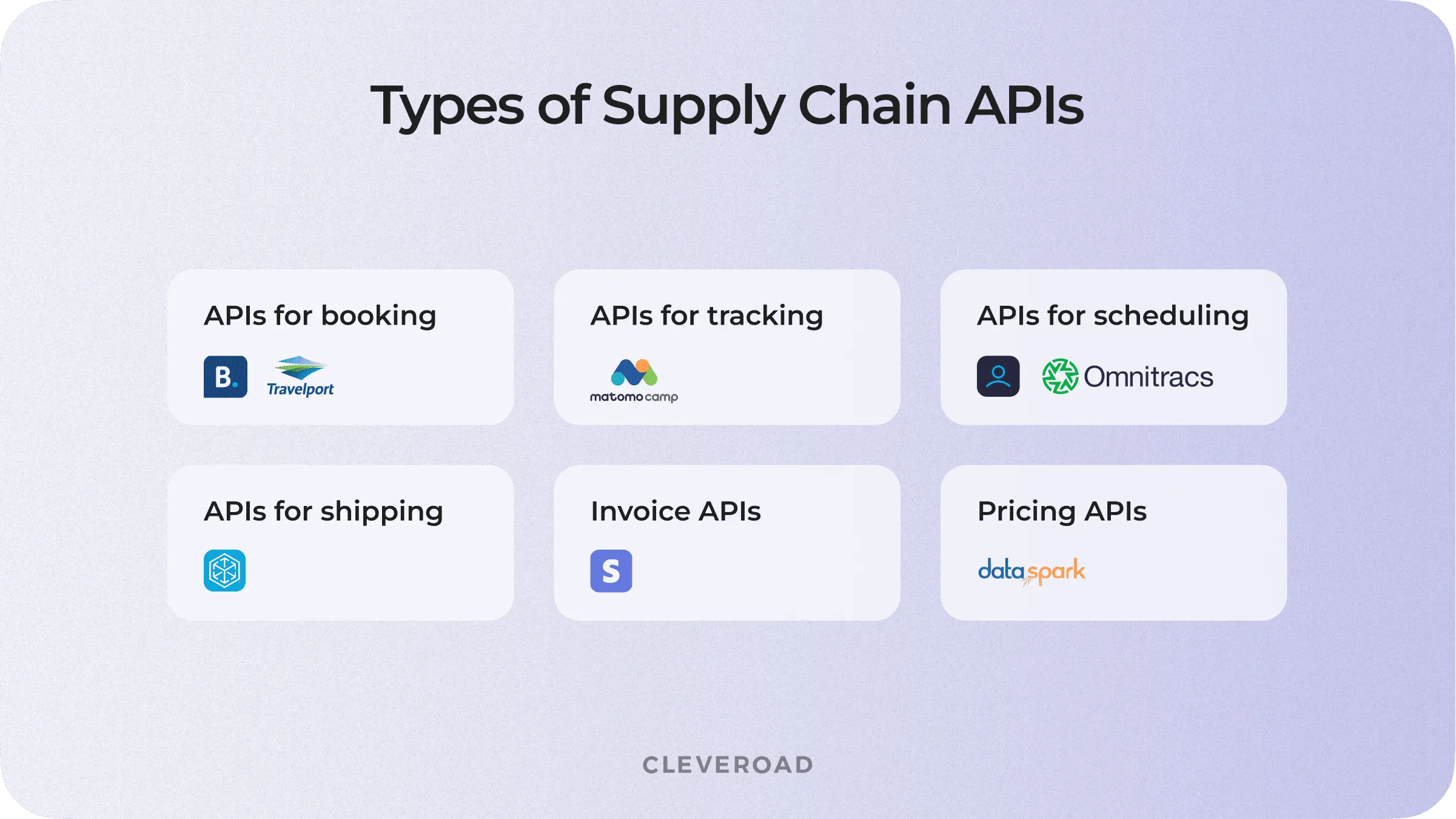
API types along with their examples
Travelport Galileo API
A supply chain company’s expansion or product improvement shouldn't be expensive. Travelport APIs may help you unlock the material you need to expand with a single straightforward, standards-based coding set of interfaces.
Matomo
Matomo is an open-source web analytics software development platform. Token authentication is needed to use the RESTful API. The Matomo Reporting API makes generating data for specific requests easier, such as reports for certain date ranges and requests for daily, weekly, monthly, and yearly periods.
Omnitracs
Omnitracs offers fleet management services for logistics in transportation. Developers may access and use Omnitracs Scheduler functionality with other apps thanks to its REST API. There is no publicly accessible documentation; an account service is required to use the API.
Humanity API
The Humanity API provides JSON-formatted replies with information on businesses, locations, jobs, and workers. The REST architecture and token-based authentication are aspects of the API. Humanity includes compliance, forecasting, flex scheduling, and mobile shift management.
C.H. Robinson
The Navisphere platform, developed by the American corporation C.H. Robinson, contains a number of APIs that you may use in your organization. The options on the list include viewing your supply chain's movements, generating orders and tender deliveries, creating instruments for invoicing, receiving regular updates on the status of packages, etc.
Stripe API
Developers have access to SCM software to Stripe's functionalities thanks to the Stripe API. This API features include handling subscription billing, issuing invoices, receiving payments, and changing and maintaining account information.
DataSpark
DataSpark sales estimator contains information on sales projections, pricing trends, purchase box winners, best-selling products by category, and more. The API provides information about items and categories, including top sellers, buy box analytics, product listings, and account details.
Booking.com Content API
This API allows specialists to create and manage listings on Booking.com or quickly publish data for hundreds of properties to the Booking.com platform. Moreover, it contains capabilities for uploading property photographs, information about commodities, and policies.
Looking through this, the supply chain API set, and thinking about a proper interface choice, keep in mind that your API should be understandable enough for your software development team to utilize. James Gosling says the following about it:
James Gosling
Canadian IT scientist and books author
An API that isn’t comprehensible, isn’t usable.
That’s why applying to an IT solution vendor with deep expertise in logistics solutions development will be reasonable when choosing a proper API for your SCM digital product. You can even simplify your job by delegating them the whole software creation process.
How to Integrate an API Into Your Supply Chain Solution
Let’s consider how the SC software development process will be performed when the tech partner takes part in it. We’ll also give you advice as to finding such a helper to collaborate with.
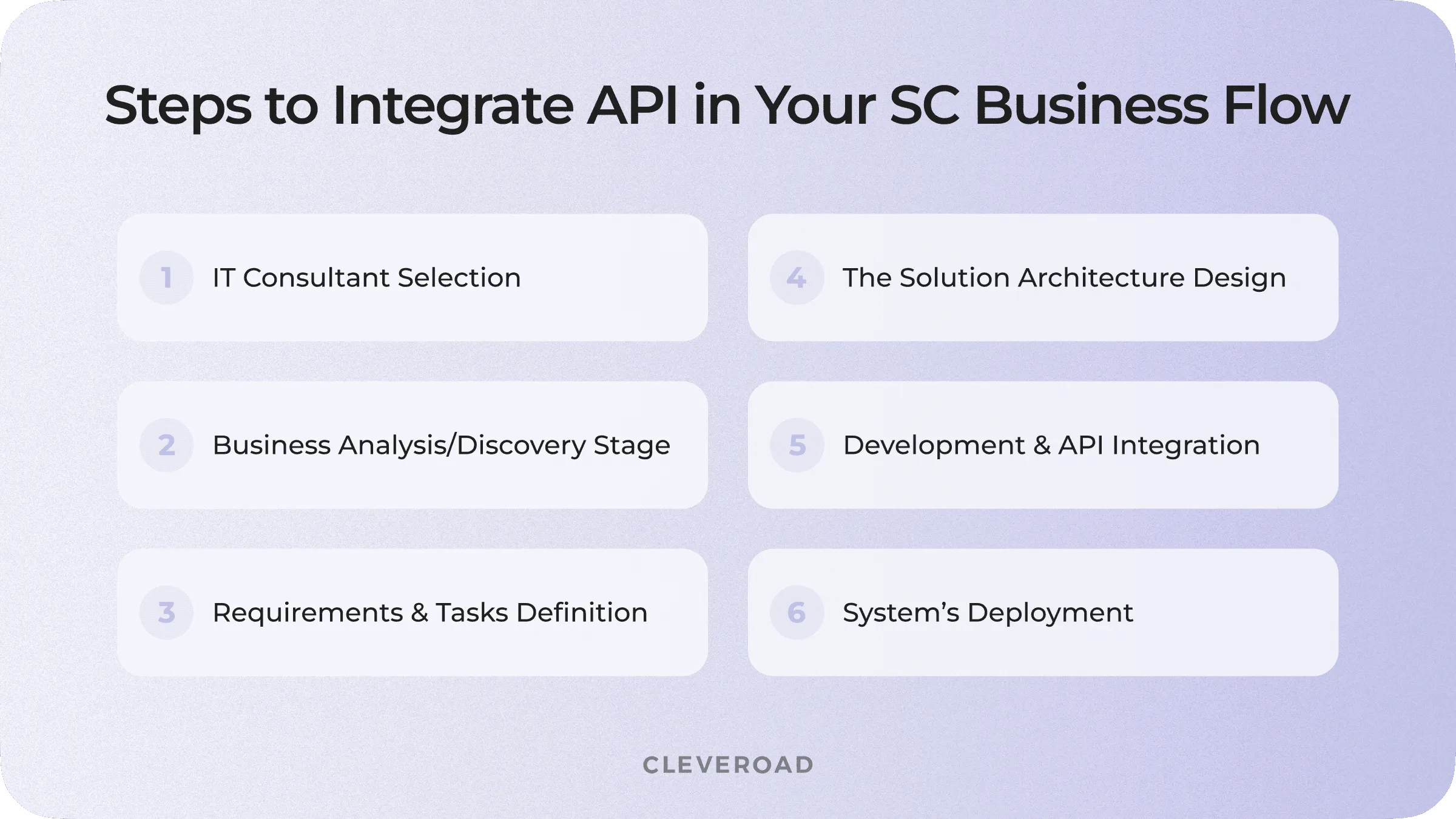
How to integrate API in your SC business flow through the software?
IT Consultant Selection
Before the system development and its integration with the appropriate API supply chain your company requires, you should gain the support of the IT tech partner skilled in logistics software creation. We’ll give you some essential advice on how to choose the right software development company.
- Don’t hire the first met company promising the best results. Instead, if you’re interested in this or that software development vendor, you should look through such platforms as ITFirms or Clutch to find more information about the company.
- Read attentively the feedback written by the previous customers of the provider. They can tell you the cooperation details you need to know as better as possible, so you may also contact them in person and ask for whatever you need.
- Message, call the vendor, or even organize a meeting with their representative. Discuss the possible collaboration’s peculiarities (e.g., the possibility of bringing your design.).
- Discuss their communication matters. To avoid any barriers in a speaking interaction, you should find out how the company schedules meetings, how tightly they communicate with their clients, and what software instruments they use for this purpose. Don’t forget whether they are fluent in the customer’s language.
- Study the vendor’s portfolio to consider the company’s expertise in the business domain you need. Then, read more about their completed projects to fully understand their competence.
If everything you’ve researched satisfies you, start cooperation with the vendor. We’ll describe how it typically happens in the example of Cleveroad’s workflow.
Business Analysis/Discovery Stage
Following your discussion of the project and the gathering of the preliminary data by the experts, you may go on to the discovery stage. It means you can come up with your drafts for the project (or even with a concept of the future software), and the specialists will perform other essential activities.
For example, they'll do a business study of your project concept, outlining the target audience for your future digital product, the corporate goals, potential competitors, and so on. They also increase the project requirements (e.g., what platforms the SCM solution will cover, what modules the product will contain, what APIs to integrate, and what business logic to implement, etc.). The IT experts will also create a project specification and specify the team composition for your project.
Requirements and Tasks Definition
Creating a list of functionality necessary to achieve the previously stated goals is what this phase entails. This functionality should act as a tool for achieving corporate goals. Also, the API is more discussed — the specialists decide on how the interfaces will be implemented into the upcoming platform and what issues they may decide on. The requirements definition stage entails designing the data flow - the components of information that must be sent from one solution to another.
The Solution Architecture Design
After evaluating all the inputs and discussing all the details with the customer (including the rough estimate), the solution team starts detailing project peculiarities. It means the architecture of the solution and integrations is created, the exact details are revealed, and the project takes a particular form.
To clarify the lacking details, the team can discuss them with the customer on special calls. The length of the stage varies depending on the project, although it often lasts two weeks or so.
Development and API Integration
Since your future system’s interface is prepared, the software is started creating incrementally, from sprint to sprint. A planning session precedes each sprint, which concludes with delivering a finished, functioning component of the project.
Initially, the Project Manager works on the sprint backlog - a list of new functionality, enhancements to current features, bug fixes, etc. The needed features are implemented by the development team. You may collaborate with various tech professionals, such as iOS, Android, or web developers, depending on the project (front-end and back-end).
The team is also integrating supply chain API at this stage. Every developed feature is thoroughly tested by QA engineers, as well as the complete functionality and API’s appropriate integration. If something goes wrong, these specialists write bug reports for developers to fix the arisen bugs.
System’s Deployment
The completed solution is thoroughly tested (e.g., performance testing, stress testing) and can be launched into work after all the verifications are completed. When you are satisfied with the outcome, the team gives you the project materials.
Keep in mind that the cooperation isn’t finished yet after the SCM solution’s deployment. The vendor then performs support and maintenance activities, checking your digital product for bugs, fixing them, or upgrading the software with new features.
You should also find out that the technical solutions for the chain of supplies are complex. That’s why you need to be guided by a skilled technical vendor acknowledged with all the peculiarities of supply chain management.
Cleveroad’s Practical Experience in Logistics and SC Solutions
To successfully implement and use a supply chain API, you need to apply to a technical consultant, preferably having experience in such integrations. At Cleveroad, we have been working for 10+ years on logistics software implementation and proving our service quality in practice.
We are a CEE-located outsourcing software development company that specializes in developing such logistics solutions as SCM, TMS, LMS, WMS, and ERP, highly required by businesses dealing with supply chain processes. Our solutions lower operating expenditures and improve shipping activities, warehousing, transportation, and others, optimizing the supply chain on the whole.
Collaborating with us, you’ll obtain the following:
- Qualitative and full-fledged logistical product fully responding to your business needs
- Innovative technology stack and IT building approach to bring your logistics and SC software ideas to life and enhance the supply chains of your company
- Assisting consumers in tracking their deliveries to boost client satisfaction
- Building custom SCM and logistics systems while taking into account the business procedures of the customer, industry standards, and distinctive UI/UX designs
- Enhancing the efficiency of an existing client logistics software by automating manual operations.
- An in-depth consultation as to the project with one of our specialists (e.g., project manager, business analyst, or solution architect)
- Using supply chain APIs and EDIs to connect carrier tools, internal platforms, or external aggregators with specifically developed SCM software
- After-development upgrading, bug-fixing, and advertisement services for our customers, etc.
During the years of Cleveroad’s existence on the market, we’ve given a proper embodiment to many logistics software ideas from our clients. One of the projects we’ve developed is a Route Planning and Transport Management System (TMS). We’ll tell you about this solution in detail.
Our customer, the fast-developing US logistics company, required a software solution to automate the route planning and enhance the everyday workflow of their employees, as well as optimize the transport management processes to increase the return on every vehicle unit.
We’ve delivered a highly flexible and customized digital product with a control module and function to manually correct data the customer needs:
- The existing route planning process was rebuilt by us to automate the entire flow and avoid a high risk of human factor mistakes. The customer’s fleet managers and dispatchers were able to correct the route themselves in case of a lack of navigation issues or maps.
- Dispatchers also obtain a responsibility to use a fleet module, which enables the creation of groups of vehicles utilized throughout the transportation workflow and may be modified to accommodate evolving business procedures. Functions of the system also include bulk uploads of CSV-formatted vehicle data.
- We have also provided truck drivers with a specialized mobile app that gives them access to the full range of navigational functions. The delivery process was also simplified by a comfortable software module developed by our specialists.
We are happy to implement your project and integrate APIs that suit your business — just write to us about your project idea! We’ll help you make an SC solution that will perfectly fit your company’s needs, be profitable, and be easy to use for your employees and customers. So let’s start cooperation that will be close, reciprocally profitable, and change your company flows for the better.
Skilled SC vendor is here to help
Apply to Cleveroad IT team to get the logistics platform integrated with carefully selected APIs
The Application Programming Interfaces (APIs) are code parts simplifying access to the collected data and functionality of the SC management solutions. They achieve such results by serving as digital mediators between software and data environments and even as interpreters of the supply chain data.
API in supply chain is the digital connector of one logistics system with the others critical to business success.
Electronic Data Interchange (EDI) means a digital exchange of documents between business partners. Due to it, many companies have increased the effectiveness of their business communication due to paperless docs. Consequently, the business operations of such companies have been improved, too, as well as their inventory.
You can use the following supply chain API types:
- Tracking API
- Scheduling API
- Shipping API
- Invoicing API
- Pricing API
- Booking API

Evgeniy Altynpara is a CTO and member of the Forbes Councils’ community of tech professionals. He is an expert in software development and technological entrepreneurship and has 10+years of experience in digital transformation consulting in Healthcare, FinTech, Supply Chain and Logistics
Give us your impressions about this article
Give us your impressions about this article
